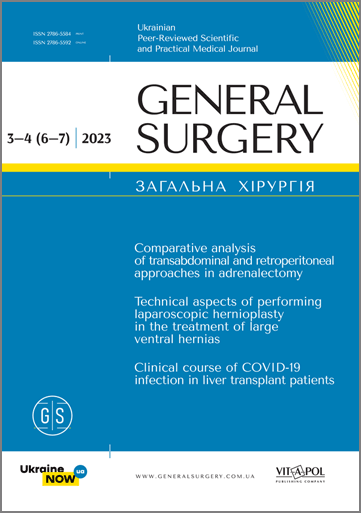Clinical course of COVID-19 infection in liver transplant patients
DOI:
https://doi.org/10.30978/GS-2023-3-35Keywords:
liver transplantation, COVID‑19, prevention, frequency, clinical courseAbstract
In the presence of chronic liver diseases, the post‑infectious period of COVID‑19 is difficult and potentially mortal. The impact of COVID‑19 on liver transplant patients has not been thoroughly investigated.
Objective — to study the characteristics of the clinical course of COVID‑19 in liver transplant patients.
Materials and methods. At the end of December 2014, the first successful liver transplant operation in Georgia was performed at the Batumi Referral Hospital of the Autonomous Republic of Adjara. To date, a total of surgical interventions have been conducted, including 42 surgeries since the beginning of the pandemic. We analysed
The incidence of COVID‑19 infection in the cohort of 88 patients throughout their hospital stay after liver transplant and at the late postoperative period was analysed, as well as the characteristics of the clinical course of COVID‑19. To prevent COVID‑19 transmission within the hospital, a special protocol been developed: to ensure that the patient is safely isolated from contact with the source of infection. In the postoperative period, all patients received immunosuppressive therapy. To monitor the course of the disease, an interdisciplinary team was created, which consisted of a transplant surgeon, hepatologist, gastroenterologist, infectious disease specialist, therapist, and immunologist. The consultation was held at the place of residence and treatment of a patient.
Results. No cases of COVID‑19 infection were reported among patients at the hospital where the liver transplant was conducted. In the late period, COVID‑19 was registered in 17 (19.3%) patients, of whom one (5.9%) died from the infection. One patient was infected with COVID‑19 twice. We have identified four variants of the clinical course of COVID‑19: mild (23.5%) — without any symptoms except for mild respiratory symptoms; aggravated (41.2%) — mild respiratory symptoms and dyspeptic symptoms without significant changes in clinical diagnostic parameters; moderate (29.4%) — cough without sputum, hyperthermia for three days, decreased sense of smell, the presence of dyspeptic symptoms, increased average values of biochemical parameters (alanine aminotransferase, aspartate aminotransferase, γ‑glutamyl transpeptidase, alkaline phosphatase, total bilirubin); severe (5.9%) — development of multiple organ failure.
Conclusions. The implemented set of preventive measures ensured the patient’s protection from COVID‑19 infection in all cases during their hospital stay. In liver transplant patients.
References
Drosten C, Gunther S, Preiser W, et al. Identification of a novel coronavirus in patients with severe acute respiratory syndrome. N Engl J Med. Available at http://content.nejm.org/cgi/content/ abstract/NEJMoa030747v1.
Ksiazek TG, Erdman D, Goldsmith C, et al. A novel coronaviruses associated with severe acute respiratory syndrome. N Engl J Med. Available at http://content.nejm.org/cgi/content/abstract/ NEJMoa030781v1.
Kulkarni AV, Tevethia HV, Premkumar M, Arab JP, Candia R, Kumar K, Kumar P, Sharma M, Rao PN, Reddy DN. Impact of COVID19 on liver transplant recipientsA systematic review and metaanalysis. EClinicalMedicine. 2021 Aug;38:101025. http://doi.org/10.1016/j.eclinm.2021.101025.
Kumar D, Tellier R, Draker R, Levy G, Humar A severe acute respiratory syndrome (SARS) in a liver transplant recipient and Guidelines for Donor SARS Screening. https://doi.org/10.1034/j.16006143.2003.00197.
Lei L, Huang X, Zhang S, Yang J, Yang L, Xu M.Comparison of Prevalence and Associated Factors of Anxiety and Depression Among People Affected by versus People Unaffected by Quarantine During the COVID19 Epidemic in Southwestern China. Med Sci Monit. 2020 Apr 26;26:e924609. http://doi.org/10.12659/MSM.924609.
Liu B, Wang Y, Zhao Y, Shi H, Zeng F, Chen Z. Successful treatment of severe COVID19 pneumonia in a liver transplant recipient. Am J Transplant. 2020 Jul;20(7):18911895. http://doi.org/10.1111/ajt.15901.
Peiris JSM, Lai ST, Poon LLM, et al. Coronavirus as a possible cause of severe acute respiratory syndrome. Lancet. Available at http://www.thelancet.com/journal/vol361/iss9365/full/ llan. 361.9365.early_online_publication.25296.1.
Saigal S, Gupta S, Sudhindran S, Goyal N, Rastogi A, Jacob M, Raja K, Ramamurthy A, Asthana S, Dhiman RK, Singh B, Perumalla R, Malik A, Shanmugham N, Soin AS. Liver transplantation and COVID19 (Coronavirus) infection: guidelines of the liver transplant Society of India (LTSI). Hepatol Int. 2020 Jul;14(4):429431. http://doi.org/10.1007/s12072020100411.
Shi S, Qin M, Shen B, Cai Y, Liu T, Yang F, Gong W, Liu X, Liang J, Zhao Q, Huang H, Yang B, Huang C. Association of Cardiac Injury With Mortality in Hospitalized Patients With COVID19 in Wuhan, China. JAMA Cardiol. 2020 Jul 1;5(7):802810. http://doi.org/10.1001/jamacardio.2020.0950.
Siddiqi HK, Mehra MR.J COVID19 illness in native and immunosuppressed states: A clinicaltherapeutic staging proposal. Heart Lung Transplant. 2020 May;39(5):405407. http://doi.org/10.1016/j.healun.2020.03.012.
World Health Organization. Case Definitions for Surveillance of Severe Acute Respiratory Syndrome (SARS). Available at http://www.who.int/csr/sars/casedefinition/en.
World Health Organization. Cumulative Number of Reported Cases of Severe Acute Respiratory Syndrome (SARS). Available at http://www.who.int/csr/sarscountry/2003_0410/en/.
Downloads
Published
How to Cite
Issue
Section
License
Copyright (c) 2024 Authors

This work is licensed under a Creative Commons Attribution-NoDerivatives 4.0 International License.






